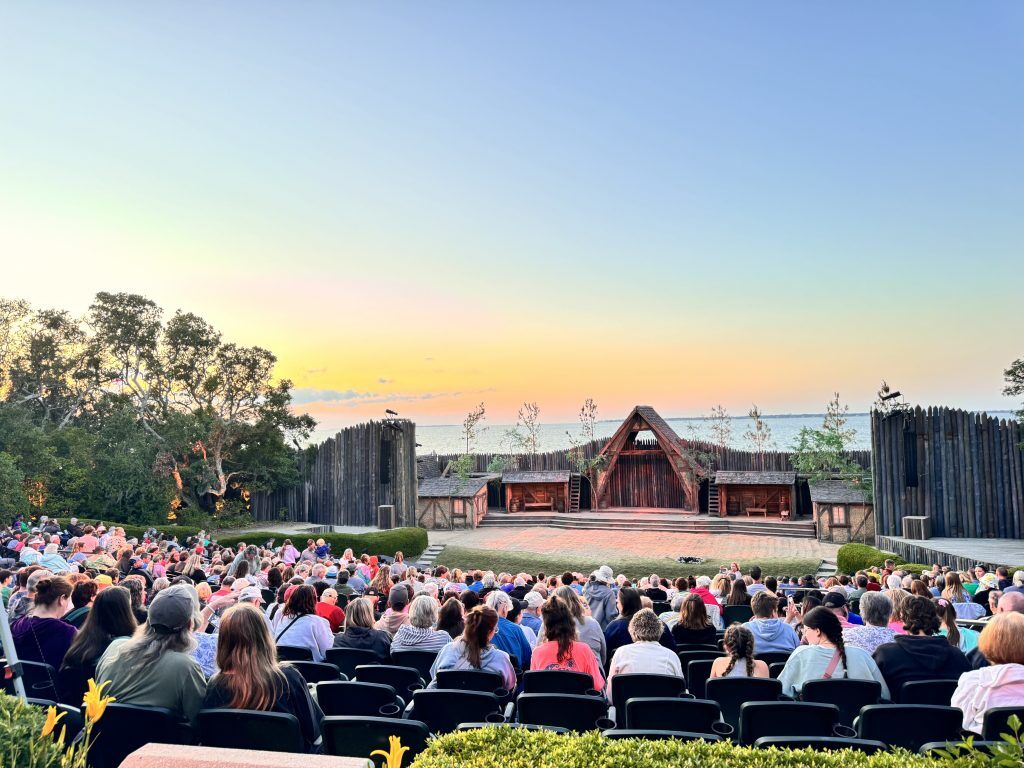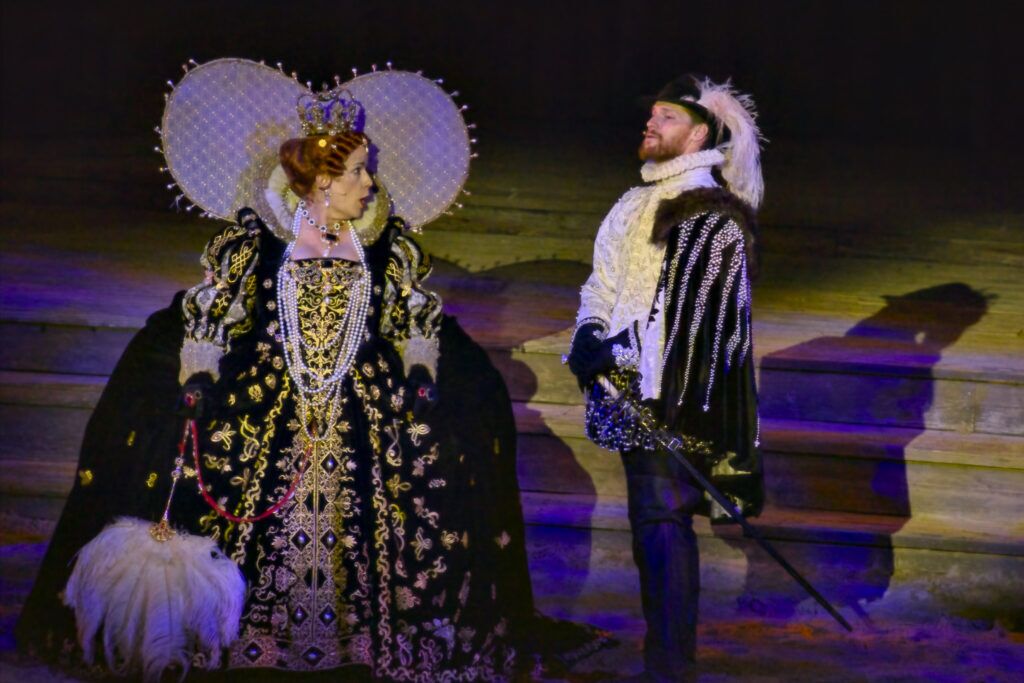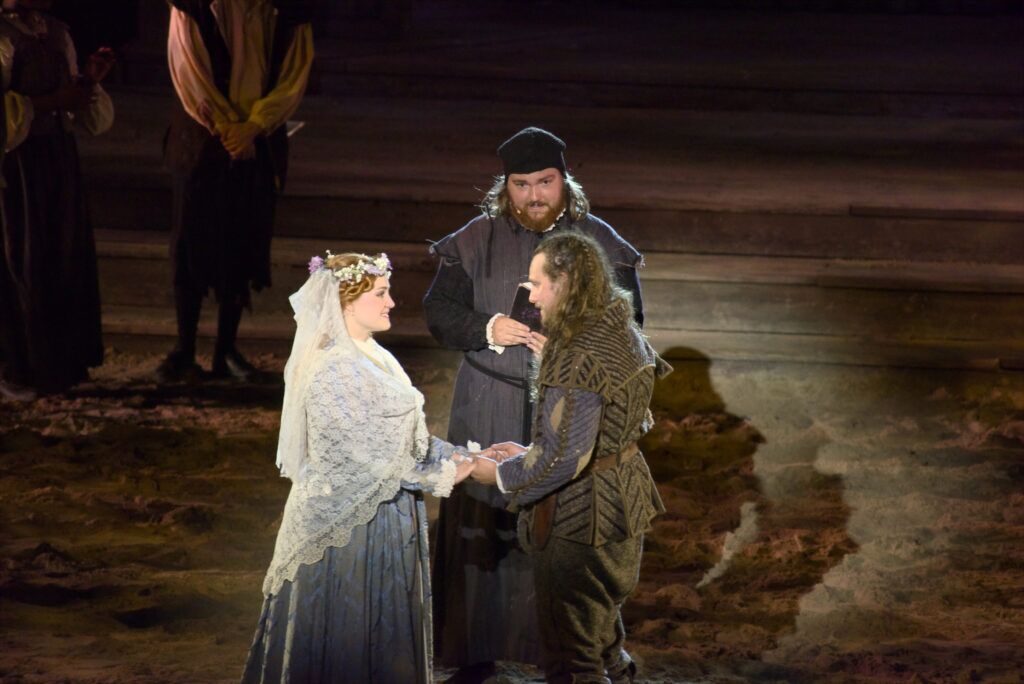
The Lost Colony
The Lost Colony Ticket Prices and Discounts (as of June 2024):
- 3 tiers of pricing are available – $40 | $35 | $25
- Seniors, Students and Military – $3 off
- Kids 12 and under are free on Monday nights
- Kids 5 and under are free
- Groups of 15 or more – 20% off
- Roanoke Island Historical Assoc. Members – $5 off
The Lost Colony Entry and Show Times (as of June 2024):
The Lost Colony begins at 8:30pm nightly and gates open at 7:30pm. On Tuesday, Friday and Saturday there is a Native American Pre-Show Presentation which begins at 8pm and is included in the price of your Lost Colony ticket.
There is a concession, bar and gift shop on site available for guests to enjoy.
For more information and ticket purchases visit www.thelostcolony.org
The Lost Colony—The Play and the Story Behind the Play (2024 update written by Kip Tabb)
The Lost Colony has opened for its 87th season. It is a play worth seeing and adding to the Outer Banks experience.
The Lost Colony was written by Pulitzer Prize-winning playwright Paul Green and first performed in 1937, the play tells the story of the 110 to 120 colonists (the historical records are unclear about just how many) who boarded ships in England and sailed for Roanoke Island hoping to create England’s first permanent settlement in the New World.
The Lost Colony has been modernized over the past 87 years, and it’s no longer accurate to say what is now on the stage was written by Paul Green. Influenced by and based on, but not written by—and that can’t be helped.

Important elements of Green’s writing have been retained, but the original Lost Colony play was written for a Depression era audience of the 1930s. The pacing of the original script is not suited for modern audiences—it’s on the slow side, and some of the dialogue—especially the Native Americans speaking in a form of Pidgin English, would be offensive to modern audiences.
What is still in the Lost Colony play are the elements that Green understood were at the heart of good theater. There is the love story of John Borden and Eleanore Dare.

Eleanore is clearly in love with Borden but is betrothed to Ananias Dare, who befriends Borden. It is all handled with honor—nary a kiss or hug between John and Eleanore until later in the play after (spoiler alert) Ananias dies in Borden’s arms.
There is the pageantry of Elizabethan England that is beautiful to behold.
There is also Old Tom, whose story parallels the story of the play. Rising from the depths of an alcoholic, homeless life on the streets of London, by the end of the play, he stands alone on the parapet of the colony’s fort, guarding the lives of the survivors of that first horrific winter.
Perhaps most importantly Manteo and Wanchese argument about what the coming of the English will mean for the Native Peoples has been retained. In dialogue that could have taken place—Wanchese and Manteo really did exist and had been in England for two years—the two Native Americans view what is happening from very different but equally valid points of view.

Wanchese argues that the English will rob the Indian nations of their land and destroy their culture. Manteo believes the English and Europeans are too numerous and powerful to withstand, and Indian’s best hope for survival is to work with English.
Also factual, three years after the expedition landed in August of 1590, John White, the colony’s governor and leader, returns to find an abandoned village, stripped of everything—including the homes—and the letters CRO carved into a tree.

The Lost Colony play is clearly historic fiction—there was no John Borden among the colonists. Old Tom is completely created out of whole cloth. As a springboard, though, learning about what really happened to the people who tried to establish the first English Colony was a fantastic experience.
We are learning more and more about that first English colony—keeping in mind that we will probably never know the full story.
The First Colony Foundation (FCF), formed in 2004, has been doing some remarkable archeological and historical research on the Lost Colony.
There were actually three expeditions to Roanoke Island. The first in 1585 was exploratory, the second in 1586 was scientific, military, and supposedly diplomatic, and the Lost Colony arrived in August of 1587.
It was the second expedition that was, in some ways, the most significant. That second expedition included the renderings of John White showing how the Native Americans lived and the remarkable observations of Thomas Harriot, the expedition’s scientist and journalist.

White created a map, the Virginia Pars Map, that was recently found to include a hidden mark at the confluence of Salmon Creek and the Chowan River in Bertie County—Site X as it has come to be known.
Excavations carried out at the site by Dr. Eric Kinglehoffer of the FCF have found artifacts from late 16th century England. Nothing conclusive but very suggestive.
Site X is just one piece of the Lost Colony puzzle. There is also what happened before the colonists arrived that almost guaranteed failure.
Wingina was the leader of the local tribal nation. Harriot referred to him as King Wingina, but whether he was a king or chief is not as important as how much influence he wielded. Within the area surrounding Roanoke Island, he was in charge.
In what may be one of the most remarkable military and diplomatic blunders in the history of England’s colonial history in the New World, Captain Ralph Lane, the military leader of the 1586 or second expedition, attacked and killed Wingina after requesting a meeting.
Here’s the story.
In an expedition into the interior, Lane captured a Native leader in the vicinity of Bertie County. Under duress, the Chief told Lane Wingina was planning on attacking him. Historians have determined there was no basis for the claim other than the captor hoping to live.
Lane travels back to Wingina’s town and requests a meeting under the guise of discussing a missing silver chalice or cup. The meeting begins, and at Lane’s signal, “Christ our victor,” the English soldiers fire their matchlock muskets into the villagers, wounding Wingina.
Wingina runs into the forest with some of Lane’s troops in pursuit. Perhaps two hours later, Edward Nugent emerges holding the head of Wingina.
The death of Wingina and the subsequent hatred of the English by the local tribal nation made success almost impossible. Although there were other factors, a drought that occurred in 1587 when the colonists arrived and the loss of supplies when their ship grounded at Cape Hatteras, without the help of the local people, the Lost Colony was doomed from the outset.
A footnote to Wingina’s death as it is depicted in the play, and is one of the few criticisms of what is on stage. In the play, Wingina’s death is marked symbolically by huge owl puppets, the symbol of death, roving across the stage.
Wingina’s death was horrific and violent. In Green’s original staging, Wingina is shot using a musket with a loud BANG. Shocking and effective, it left no doubt about why the local people were attacked later in the play.
The Lost Colony was first performed in 1937 as a way to commemorate the 350th anniversary of the birth of Virginia Dare, the first English-born child in America. The show is performed at the Waterside Theater on Roanoke Island and typically runs through the summer months. The Lost Colony was recently named one of Summer’s 10 Best Outdoor Theater Experiences by Fodor’s Travel and has been seen by over three million people in its years of being performed.
A few fun facts about The Lost Colony performance: The stage is over three times larger than most Broadway stages in New York City; It is the nation’s longest-running outdoor performance; The production has over 120 actors, technicians, designers, and volunteers.
While visiting the Outer Banks, come witness the compelling production about an English colony that settled on Roanoke Island many, many years ago.
